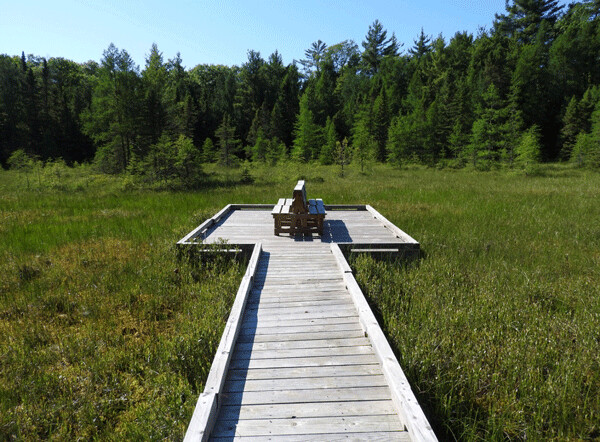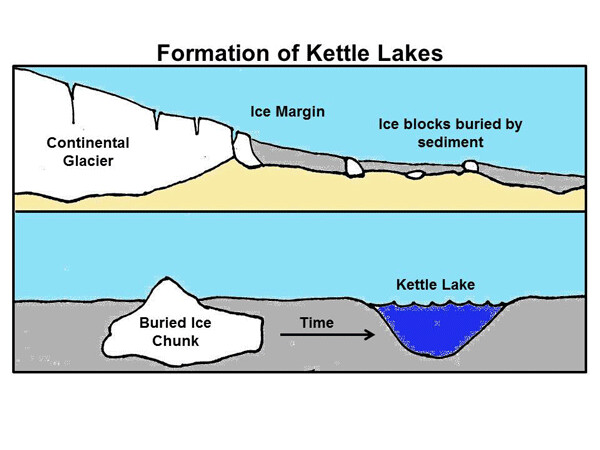News & Articles
Browse all content by date.

Recent rains and warm days have caused a rapid retreat of our snowpack. The resulting landscape of brown duff and soggy mud isn’t very attractive, but little green shoots are popping up, and soon our landscape will again be festooned with flowers.
This annual transformation is a little reminder of how the extended winter of glaciation shaped our region – including the Forest Lodge Nature Trail. Here are two sections from the trail’s new interpretive booklet to summarize that history.

Geology
The hill you just climbed pales in comparison to the mountains that towered over northern Wisconsin more than a billion years ago. All those years of erosion wore the Alps-like Penokee Range, located just to the northeast, into big rolling hills.
Right here, the landscape was shaped by glaciers. Glaciers are made of many layers of snow from thousands of winters that were compacted into ice under their own weight. The Wisconsin Glaciation began about 100,000 years ago when ice advanced south out of Canada, and the last glacier melted out of Wisconsin by about 13,000 years ago.
As glaciers flowed slowly across the land, they broke apart bedrock, carried the pieces away within the ice mass, and then laid down thick sedimentary deposits in new places. Like giant conveyor belts, glaciers transported tons of boulders, gravel, sand and clay.
When the climate began to warm again, the ice melted faster here at its toe than new snow in Canada could replenish it. Huge chunks of ice broke off from the main ice mass and were left behind at edges of the melting glacier. Rivers of meltwater from the glaciers carried sediment that buried those ice chunks. Now well-insulated, the ice lay hidden under a flat surface of sand, gravel and cobbles for many years. When the ice chunks finally melted, basins of all shapes and sizes were left behind where the ice had been.

Sometimes these basins, called kettles, filled with water and became lakes (like Lake Namakagon); others are perched above the water table and stay dry. The hills between the kettles are called kames. Glaciers shaped the land you stand on. A
s you continue hiking, notice the shapes of hills and basins. Can you image the size of the ice chunks that were once buried here?
Bogs and Fens
Wetlands are important habitats in the Northwoods. They filter water, reduce flooding, and provide food and shelter for many living things. There are four main types of wetlands.
Marshes have soft-stemmed plants and saturated soil.
Swamps have wet soils and are dominated by trees and shrubs.
Fens have mostly soft-stemmed plants and mucky-peat soil containing poorly decomposed plants. They are influenced by groundwater and by runoff from the surrounding slopes. Some fens receive nutrients like calcium from their water source. Other fens are nutrient-poor and acidic.
Bogs have sphagnum moss; small shrubs, and peat soil made of poorly decomposed plants. They only receive water from precipitation, not from groundwater or runoff. Bogs are nutrient-poor and acidic.
The main wetland on the Forest Lodge Nature Trail sits in a glacial kettle. It formed when an ice chunk left behind by the melting glacier was buried by sediment and then melted slowly over time.
Water filled the basin. Plants began to grow around its edges, and sphagnum moss grew on those plants like scaffolding. Dead plants sank to the bottom, but did not decompose in the cold, acidic water. Eventually, the mat of vegetation crept in from the edges, and organic matter accumulated on the bottom.
Over time, the lake filled in with peat, which is made of poorly decomposed dead plants. Although this process has been going on for thousands of years, as recently as 1986 there was open water in the middle of the wetland.
Is this wetland a bog or a fen? Although many of the plants in this wetland are commonly found in bogs, and it has sphagnum moss, you can see that this basin is connected to water flowing across the landscape (and under the bridge you crossed earlier). That makes it a fen. But the groundwater here is not nutrient rich, so it is a “poor fen,” that has many characteristics in common with bogs.
Mud season is a great time to observe how water travels – and puddles – across our glacially carved landscape. Remember that if you go for a hike on the Forest Lodge Nature Trail, and be sure to wear appropriate shoes! It is better for the trail if you walk through the center of a puddle instead of walking around and accidentally widening the impact.
Emily’s second book, Natural Connections: Dreaming of an Elfin Skimmer, is now available to purchase at www.cablemuseum.org/books. Or order it from our friends at redberybooks.com to receive free shipping! For more than 50 years, the Cable Natural History Museum has served to connect you to the Northwoods. The Museum is currently closed due to COVID-19, but we're still building our new exhibit and bringing you educational content. Connect with us on Facebook and Instagram to see what we are up to.
| Tweet |


